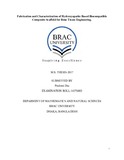| dc.contributor.advisor | Choudhury, Dr. Naiyyum | |
| dc.contributor.advisor | Asaduzzaman, Dr. S. M. | |
| dc.contributor.author | Das, Poulomi | |
| dc.date.accessioned | 2018-01-17T05:05:09Z | |
| dc.date.available | 2018-01-17T05:05:09Z | |
| dc.date.copyright | 2017 | |
| dc.date.issued | 2017 | |
| dc.identifier.other | ID 14276002 | |
| dc.identifier.uri | http://hdl.handle.net/10361/9089 | |
| dc.description | This dissertation is submitted in Partial Fulfillment of the Requirements’ for the Degree of Master of Science in Biotechnology 2017. | en_US |
| dc.description | Cataloged from PDF version of dissertation. | |
| dc.description | Includes bibliographical references (pages 74-93). | |
| dc.description.abstract | Bone tissue engineering with cells and synthetic extracellular matrix represents a new approach for the regeneration of mineralized tissue for the transplantation of bone. Hydroxyapatite and its composite with biopolymers are extensively developed and applied in bone tissue regeneration. The main aim of this study was to fabricate and characterize a biomimetic scaffolds through thermal inducing phase separation technique and cross-linked using physical and chemical method. In this regard, two biomimetic [Hydroxyapatite/chitosan-alginate (HCA) and Hydroxyapatite/collagen-chitosan (HCC)] scaffolds were fabricated and characterized by porosity & density, swelling kinetics, biodegradability, fourier transform infrared spectroscopy (FTIR), scanning electron microscope (SEM) analysis and also compared with human bone allograft (HBA).
Following the freeze drying technique, HCA scaffold was prepared in two different ratios (2:1 and 1:1). A cross linker agent, 2-Hydroxylmethacrylate (HEMA) was added at different percentage (0.5% - 2%) into the selected composition and irradiated at 5 kGy - 25 kGy to optimize the proper mixing of components in the presence of HEMA. Porosity of the prepared scaffold was nearly similar to the Human Bone Allograft (HBA) and the value was 62% to 86%. However, density of the scaffold was comparatively lower (0.004 g/cm3 - 0.076 g/cm3) than HBA. Nonetheless, in-vitro biodegradation analysis showed that the remaining weight of scaffold was lower (10% - 50%) than HBA. FTIR analysis depicted the intermolecular interaction between components in the scaffold. Pore size of a scaffold was nearly comparable (162 μm - 510 μm) with HBA.
Again, another scaffold HCC was fabricated through freeze drying method and cross-linked using chemical cross-linker (HEMA & glutaraldehyde solution) and physical cross linker (de-hydrothermal treatment). In this study, porosity and density of the prepared scaffold were 90.64% to 96.21% and 0.004 g/cm3 to 0.076g/cm3 respectively. In contrast, scaffold had nearly similar biodegradation rate (10% - 55%) than HBA. FTIR analysis showed intermolecular interaction between components in the scaffold. Pore size of a scaffold was nearly comparable (111.80 μm - 212.60 μm) with HBA.
Finally, scaffold (HCA and HCC) samples were compared with HBA to determine the best scaffolds that mimic the human bone. The porosity of HBA was found 96%; comparing with the
XVII
other two samples (HCA and HCC), it was 86% and 91%, which is closely enough to the HBA. Then density properties showed huge difference among three samples; i.e, for HBA, it showed 0.625 g/cm3 and HCC sample showed 0.183 g/cm3 but HCA sample showed 0.076 g/cm3, which was very poor comparing to the HBA. In the contrast, the water uptaking rate varied drastically, in which HCA showed highest water absorption rate 354.61% and HCC showed 307.23% but water absorption rate for HBA was 51.30%. Further, comparing the degradation properties among HBA, HCA and HCC; it was found that the remaining weight of sample HCA and HCC for day 1 & day 7 were 78.57 & 50% and 90 & 87% consequently; whilst remaining weight of HBA was found to be 89% for day 1 and 80.82% for day 7, which is closely related with HBA. Pore size of the scaffold was nearly comparable (162 μm - 510 μm) and (111.80 μm - 212.60 μm) for HCA and HCC with HBA (420 μm - 623μm). Above results suggest that the porous bone scaffolds that were fabricated in this study might be a potential bone substitute to be used in reconstructive surgery. | en_US |
| dc.description.statementofresponsibility | Poulomi Das | |
| dc.format.extent | 101 pages | |
| dc.language.iso | en | en_US |
| dc.publisher | BRAC University | en_US |
| dc.rights | BRAC University thesis are protected by copyright. They may be viewed from this source for any purpose, but reproduction or distribution in any format is prohibited without written permission. | |
| dc.subject | Hydroxyapatite | en_US |
| dc.subject | Biocompatible composite scaffold | en_US |
| dc.subject | Bone tissue engineering | en_US |
| dc.subject | HCC, HCA | en_US |
| dc.title | Fabrication and characterization of hydroxyapatite based biocompatible composite scaffold for bone tissue engineering | en_US |
| dc.type | Dissertation | en_US |
| dc.contributor.department | Department of Mathematics and Natural Sciences, BRAC University | |
| dc.description.degree | M. Biotechnology | |

